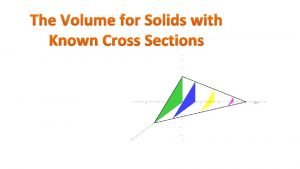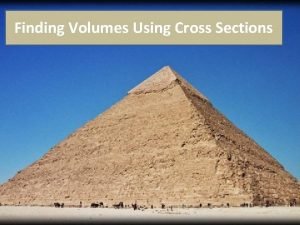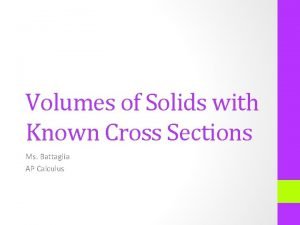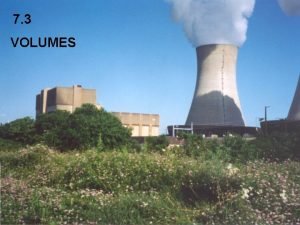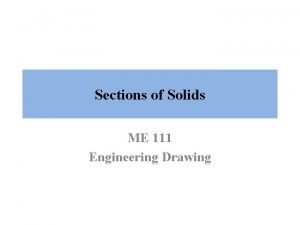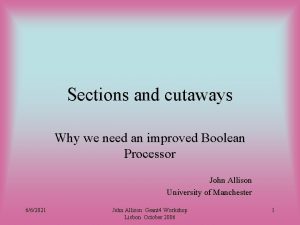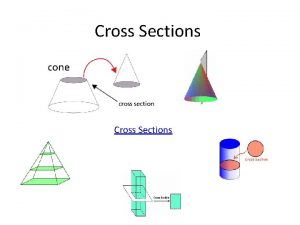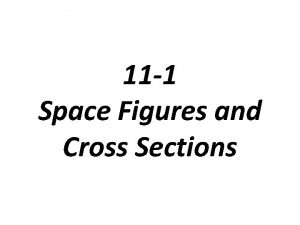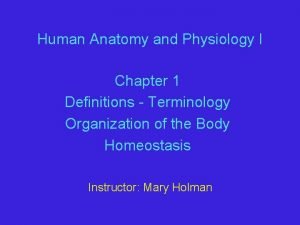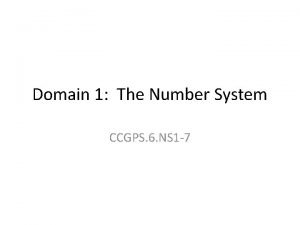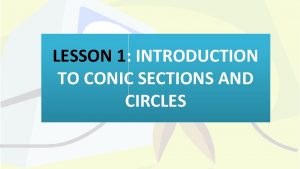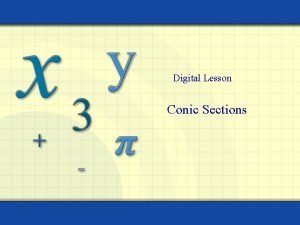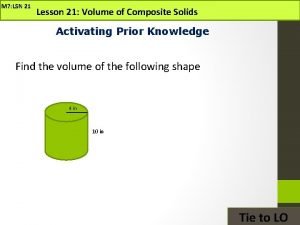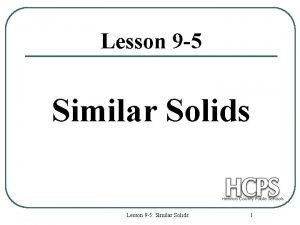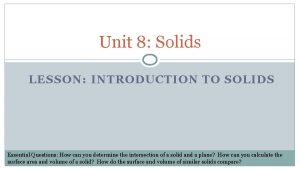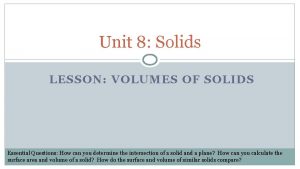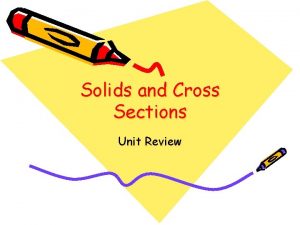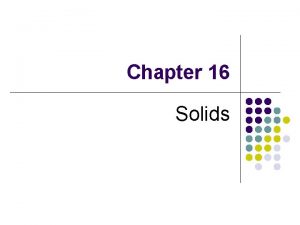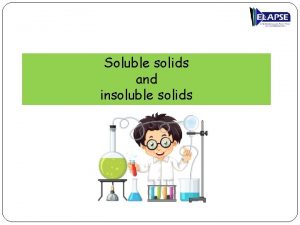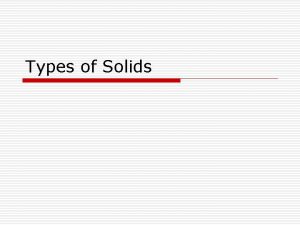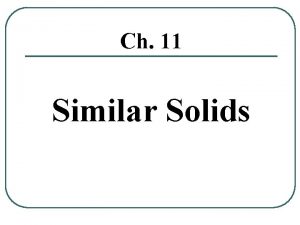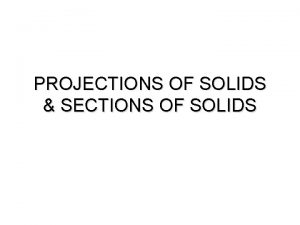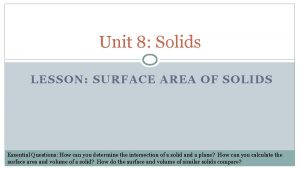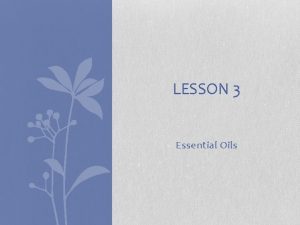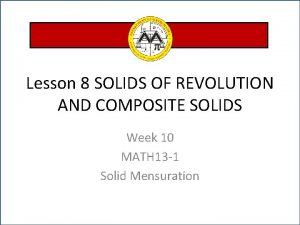Unit 8 Solids LESSON SOLIDS CROSS SECTIONS Essential



















- Slides: 19

Unit 8: Solids LESSON: SOLIDS & CROSS SECTIONS Essential Questions: How can you determine the intersection of a solid and a plane? How can you calculate the surface area and volume of a solid? How do the surface and volume of similar solids compare?

Solids Goals: To recognize solids and their parts. To visualize cross sections of solids. Essential Understandings: You can analyze polyhedrons by using relationships between vertices, edges and faces and a sphere by its radius.

Solids Goals: To recognize solids and their parts. To visualize cross sections of solids. Essential Understandings: You can analyze polyhedrons by using relationships between vertices, edges and faces and a sphere by its radius.

Solids Goals: To recognize solids and their parts. To visualize cross sections of solids. Essential Understandings: You can analyze polyhedrons by using relationships between vertices, edges and faces and a sphere by its radius.

Solids Goals: To recognize solids and their parts. To visualize cross sections of solids. Essential Understandings: You can analyze polyhedrons by using relationships between vertices, edges and faces and a sphere by its radius.

Solids Goals: To recognize solids and their parts. To visualize cross sections of solids. Essential Understandings: You can analyze polyhedrons by using relationships between vertices, edges and faces and a sphere by its radius.

Solids Goals: To recognize solids and their parts. To visualize cross sections of solids. Essential Understandings: You can analyze polyhedrons by using relationships between vertices, edges and faces and a sphere by its radius.

Solids Goals: To recognize solids and their parts. To visualize cross sections of solids. Essential Understandings: You can analyze polyhedrons by using relationships between vertices, edges and faces and a sphere by its radius.

Solids Goals: To recognize solids and their parts. To visualize cross sections of solids. Essential Understandings: You can analyze polyhedrons by using relationships between vertices, edges and faces and a sphere by its radius.

Solids Goals: To recognize solids and their parts. To visualize cross sections of solids. Essential Understandings: You can analyze polyhedrons by using relationships between vertices, edges and faces and a sphere by its radius.

Solids Goals: To recognize solids and their parts. To visualize cross sections of solids. Essential Understandings: You can analyze polyhedrons by using relationships between vertices, edges and faces and a sphere by its radius.

Solids Goals: To recognize solids and their parts. To visualize cross sections of solids. Essential Understandings: You can analyze polyhedrons by using relationships between vertices, edges and faces and a sphere by its radius.

Solids Goals: To recognize solids and their parts. To visualize cross sections of solids. Essential Understandings: You can analyze polyhedrons by using relationships between vertices, edges and faces and a sphere by its radius.

Solids Goals: To recognize solids and their parts. To visualize cross sections of solids. Essential Understandings: You can analyze polyhedrons by using relationships between vertices, edges and faces and a sphere by its radius.

Solids Goals: To recognize solids and their parts. To visualize cross sections of solids. Essential Understandings: You can analyze polyhedrons by using relationships between vertices, edges and faces and a sphere by its radius.

Solids Goals: To recognize solids and their parts. To visualize cross sections of solids. Essential Understandings: You can analyze polyhedrons by using relationships between vertices, edges and faces and a sphere by its radius.

Solids Goals: To recognize solids and their parts. To visualize cross sections of solids. Essential Understandings: You can analyze polyhedrons by using relationships between vertices, edges and faces and a sphere by its radius.

Solids Draw the cross section formed by a plane intersecting the top, front, and left faces of a cube but none of the other faces and none of the vertices. Goals: To recognize solids and their parts. To visualize cross sections of solids. Essential Understandings: You can analyze polyhedrons by using relationships between vertices, edges and faces and a sphere by its radius.

Soldis � Homework: Worksheet 11. 1 • Select Problems
 Solids of known cross sections
Solids of known cross sections Volume using cross sections calculator
Volume using cross sections calculator Area of triangle formula
Area of triangle formula Solids with known cross sections
Solids with known cross sections Sections of solids engineering drawing
Sections of solids engineering drawing Sectional top view of cone
Sectional top view of cone Lesson 1 thermal energy and the behavior of matter
Lesson 1 thermal energy and the behavior of matter Cutaways and cross sections definition
Cutaways and cross sections definition Cross section slice
Cross section slice Cone diagonal cross section
Cone diagonal cross section 11-1 space figures and cross sections answer key
11-1 space figures and cross sections answer key Medial lateral distal proximal
Medial lateral distal proximal Volumes of known cross sections
Volumes of known cross sections Characteristics of lipids
Characteristics of lipids Lesson 1 exploring conic sections
Lesson 1 exploring conic sections Lesson 1 exploring conic sections
Lesson 1 exploring conic sections Hyp opp adj
Hyp opp adj Lesson 21 volume of composite solids
Lesson 21 volume of composite solids Similar solids lesson
Similar solids lesson Unit 10, unit 10 review tests, unit 10 general test
Unit 10, unit 10 review tests, unit 10 general test
